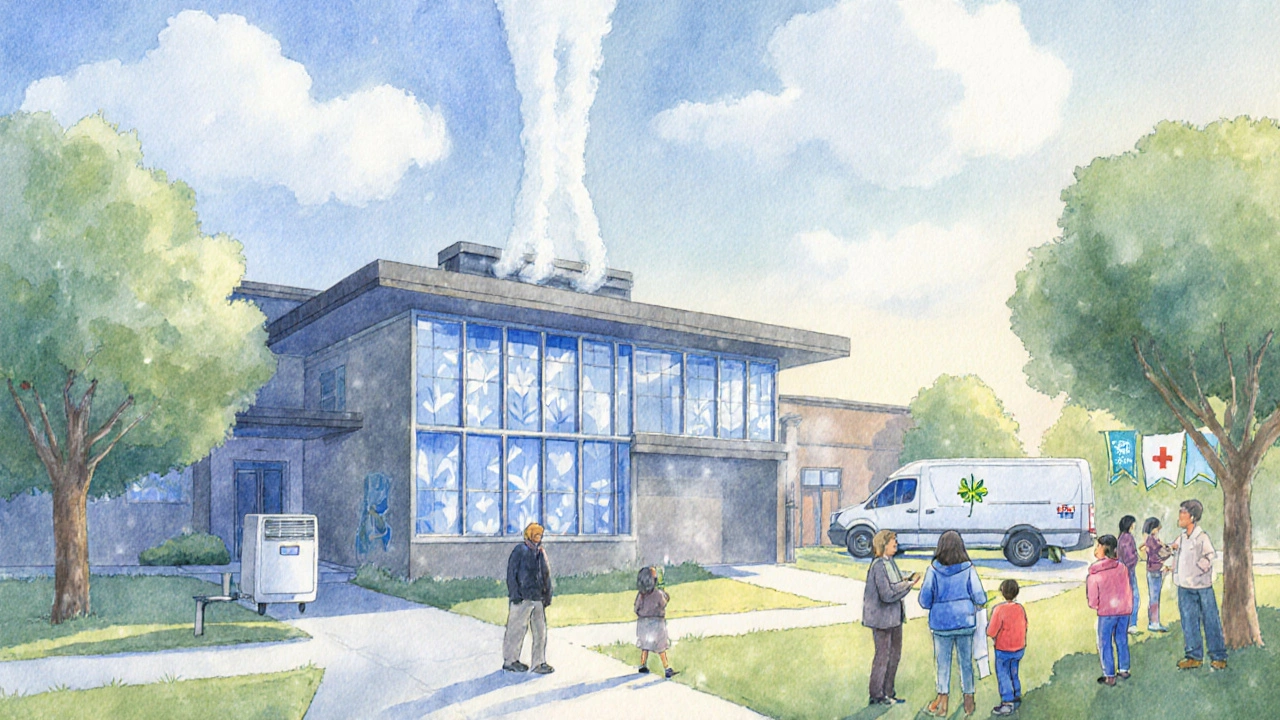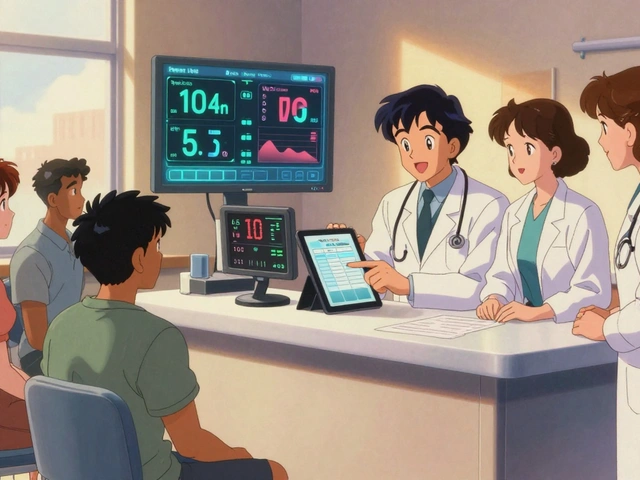Climate Impact on Flu Season Calculator
Projected Flu Season Changes
Transmission Risk
-
Season Duration
-
Virus Mutation
-
Every winter we hear about a bad flu season, but the story behind those spikes is getting more complicated. Climate change the long‑term increase in global average temperatures caused by greenhouse‑gas emissions is rewiring how the influenza virus moves, when it thrives, and who it hurts. Understanding this link helps public‑health officials plan better vaccines, and it lets anyone see why a warmer world could mean a stranger flu pattern in your hometown.
Quick Takeaways
- Warmer winters and milder summers shift the traditional flu season, extending it in many regions.
- Higher humidity in some areas can suppress flu transmission, while low humidity in others boosts it.
- Changes in bird migration and animal reservoirs bring new flu strains closer to human populations.
- Predictive models suggest a 10‑15% rise in annual flu cases globally by 2050 if emissions stay on current paths.
- Targeted vaccination timing and improved surveillance are the most effective defenses.
What is Influenza?
Influenza an acute respiratory infection caused by influenza viruses A, B, and C spreads through droplets, aerosols, and contaminated surfaces. It mutates quickly, creating new subtypes that can dodge immunity from previous infections or vaccines. In a typical year, the World Health Organization (WHO) estimates 290,000‑650,000 respiratory deaths worldwide, with the highest burden in the very young, the elderly, and people with chronic conditions.
How Climate Shapes Flu Transmission
The virus doesn’t exist in a vacuum; temperature and humidity directly affect its survival outside the host. Laboratory studies show that at 5‑10°C and low relative humidity (<40%), influenza particles remain viable for up to 24hours, dramatically increasing infection risk. Conversely, when temperatures rise above 20°C and humidity exceeds 60%, the virus loses infectivity within an hour.
Two climate‑driven mechanisms matter most:
- Temperature‑humidity envelope: Cold, dry air preserves viral particles, while warm, moist air deactivates them. As winters become milder in temperate zones, the “envelope” shifts, sometimes extending the period when conditions are favorable for spread.
- Human behavior: People cluster indoors when it’s cold. Warmer winters can reduce indoor crowding, but in many regions milder temperatures also encourage outdoor gatherings where aerosol spread can still occur, especially if humidity remains low.

Evidence of Changing Flu Patterns
Data from the Centers for Disease Control and Prevention the U.S. federal agency responsible for public health surveillance reveal three clear trends over the past two decades:
- Peak flu activity in the Northern United States now starts, on average, two weeks later than it did in the 1990s.
- Southern states, traditionally seeing a shorter flu window, are experiencing a 30% increase in weekly case counts during the summer months.
- Global surveillance shows a north‑south “flattening” of flu season intensity, with tropical regions reporting more “off‑season” spikes.
These shifts line up with climate data from the Intergovernmental Panel on Climate Change (IPCC): average winter temperatures in the U.S. have risen by 2.1°F since 1980, and global average humidity has become more variable, with dry spells lengthening in many mid‑latitude areas.
Future Projections: What 2030‑2050 Might Look Like
Researchers using coupled climate‑epidemiology models (e.g., the ‘FluCast’ system) forecast the following scenarios if greenhouse‑gas emissions continue on their current trajectory:
| Scenario | Average Winter Temp Change | Projected Annual Cases ↑ | Geographic Shift |
|---|---|---|---|
| RCP 4.5 (moderate mitigation) | +1.8°F | +8% | Higher latitudes see longer seasons |
| RCP 8.5 (business‑as‑usual) | +3.6°F | +15% | Temperate zones blend with subtropics; summer spikes rise |
Beyond temperature, changing bird migration patterns-driven by shifting food sources and habitat loss-are bringing novel avian influenza strains closer to domestic poultry and, eventually, humans. The WHO has already flagged increased surveillance of H5N1 and H7N9 in regions where migratory routes now overlap with densely populated agricultural zones.
Public‑Health Implications
When flu seasons become less predictable, vaccine formulation faces a tougher job. The WHO’s twice‑yearly recommendation process depends on clear, seasonal virus dominance. A smeared season means more uncertainty about which strains to include, potentially lowering vaccine efficacy by 5‑10%.
Healthcare systems also need to adapt. Hospitals in regions that historically saw minimal flu burden during summer months are now allocating resources (e.g., antiviral stockpiles) year‑round. Staff training on recognizing atypical flu presentations-such as milder fevers coupled with severe respiratory distress in warm climates-is becoming a priority.

Mitigation and Adaptation Strategies
Addressing the climate‑flu link requires actions on two fronts:
- Emission reductions: Slowing global warming directly curtails the environmental drivers of flu spread. Policies that limit carbon output also preserve ecosystems that act as buffers for zoonotic spillover.
- Targeted health interventions: Enhanced surveillance (e.g., wastewater monitoring), flexible vaccination schedules, and public‑awareness campaigns about indoor ventilation can offset climate‑induced risks.
Some cities are already testing “smart ventilation” in schools-automated HVAC systems that adjust based on indoor humidity and CO₂ levels, cutting aerosol concentrations by up to 40%. Meanwhile, the CDC’s FluFlex program pilots a rolling vaccine update approach, releasing supplemental doses in response to early‑season outbreaks detected through real‑time data streams.
Key Takeaway for Individuals
Even if you can’t control the planet’s temperature, you can lower your flu risk:
- Get the flu shot early-especially if you live in a region where the season is starting later.
- Keep indoor humidity between 40‑60% during winter; small humidifiers can make a big difference.
- Ventilate rooms regularly, even when it’s cold outside.
- Stay informed about local outbreak alerts, which are increasingly posted on city health department dashboards.
Frequently Asked Questions
Why does low humidity increase flu transmission?
Dry air evaporates moisture from the thin layer of fluid that carries the virus in our nasal passages, allowing viral particles to remain airborne longer and travel farther. This makes it easier for the virus to reach a new host.
Will warmer winters mean fewer flu deaths?
Not necessarily. While milder winters can reduce indoor crowding, they also extend the window of favorable temperature‑humidity conditions in many regions, potentially leading to more cases overall. The net effect depends on local climate shifts and how well health systems adapt.
How does bird migration affect human flu outbreaks?
Migratory birds carry avian influenza viruses. Climate change alters their routes and timing, often bringing them into closer contact with domestic poultry farms. When viruses jump from birds to humans, they can spark new seasonal strains that blend with existing human flu viruses.
What can cities do to prepare for shifting flu seasons?
Invest in year‑round surveillance infrastructure, adopt flexible vaccination campaigns, and promote building standards that maintain optimal indoor humidity and ventilation. Public‑health messaging should emphasize that flu risk is no longer strictly a winter problem.
Are there any new flu treatments linked to climate research?
Research into antiviral drugs that remain effective across a broader range of viral mutations is accelerating, partially funded by climate‑focused health grants. Additionally, rapid‑test kits that can be deployed in outdoor clinics during unexpected summer spikes are being piloted.







Ragha Vema
October 5, 2025 AT 12:55Yo, have you ever thought that the flu season might be the perfect cover for some shadowy agenda? The way the temps are climbing feels like the planet is sending us a secret invitation to a new kind of misery, and the powers that be are just sitting pretty while we cough our way through it. I swear, every time I tune into the news, they downplay the link like it’s a coincidence. Maybe the real epidemic is the one they don’t want us to see – the one that keeps us distracted.
Scott Mcquain
October 6, 2025 AT 00:01It is deeply concerning, indeed, that we allow such complacency to persist, for the sake of comfort, we must demand rigorous scrutiny, and reject the notion that climate‑driven flu shifts are merely anecdotal; responsible stewardship of public health obligates us to act.
kuldeep singh sandhu
October 6, 2025 AT 11:08While the drama is entertaining, the data actually suggest that many regions will see a contraction of flu season length, not an endless stretch. Warmer winters can reduce the virus's survival time outdoors, and that’s a fact worth noting.
Mariah Dietzler
October 6, 2025 AT 22:15i dont think this whole thing is that big of a deal, its just more flu like usual, rn.
Nicola Strand
October 7, 2025 AT 09:21Contrary to popular belief, the correlation between rising temperatures and prolonged influenza outbreaks is not unequivocal; several peer‑reviewed studies highlight regional heterogeneity that must be acknowledged.
Jackie Zheng
October 7, 2025 AT 20:28Indeed, the scientific narrative is far more nuanced than a simple cause‑and‑effect. One might argue that the virus's adaptability, coupled with human mobility, plays a larger role than temperature alone. Philosophically speaking, we are reminded that nature resists reductionist explanations.
Hariom Godhani
October 8, 2025 AT 07:35Friends, let us gather our thoughts and examine the grand tapestry that climate change weaves upon the fragile fabric of human health. The first thread to consider is the undeniable rise in average global temperatures, a phenomenon that subtly extends the window of viral survivability. When winters grow milder, influenza viruses find themselves liberated from the harsh freeze that once curtailed their spread, allowing them to linger in the environment for longer periods. Secondly, humidity shifts-dry air caves in on our respiratory passages, making them more susceptible to infection, while overly humid conditions can suppress viral particles, a delicate balance that varies by locale. Third, migratory patterns of birds and other animal reservoirs are being altered; these creatures act as silent carriers, introducing novel strains into populations that have never encountered them before. Fourth, the socioeconomic stressors accompanying climate upheaval-food insecurity, displacement, and strained healthcare systems-create fertile ground for outbreaks to blossom unchecked. Fifth, predictive modeling conducted by leading epidemiologists indicates a probable 10‑15 % increase in global flu cases by mid‑century if emission trajectories remain unchanged. Sixth, vaccine timing must adapt, shifting forward in the calendar to pre‑empt the elongated season, lest we miss the optimal immunization window. Seventh, public health surveillance must become more granular, integrating climate data streams to forecast hotspots with greater precision. Eighth, education campaigns should emphasize not only hand hygiene but also indoor humidity control, a simple yet often overlooked preventive measure. Ninth, the interplay between air pollution and respiratory vulnerability cannot be ignored; polluted air compounds the burden on lungs already battling viral invaders. Tenth, governmental policy must prioritize green infrastructure, for cleaner air translates to fewer complications during flu season. Eleventh, community resilience initiatives-vaccination drives, accessible clinics-must be bolstered to counteract the inequities that climate change exacerbates. Twelfth, researchers should invest in universal flu vaccine research, acknowledging that seasonal adjustments may become the norm rather than the exception. Thirteenth, interdisciplinary collaboration between climatologists, virologists, and sociologists is essential to craft comprehensive response strategies. Fourteenth, personal responsibility still matters; staying hydrated, maintaining adequate rest, and monitoring local health advisories can mitigate individual risk. Finally, let us remember that the story of climate and flu is still being written, and our collective actions today will script the chapters of tomorrow’s public health landscape.
Jackie Berry
October 8, 2025 AT 18:41I hear you, and I think the key takeaway is that we need to stay adaptable. When the season stretches, adjusting our vaccination schedule and keeping an eye on local forecasts can make a big difference. It’s not about panic, just about being prepared.
Mikayla May
October 9, 2025 AT 05:48Here’s a quick rundown: warmer winters can prolong viral viability, low humidity boosts aerosol transmission, and shifting bird migration introduces new strains. Public‑health officials should consider earlier vaccine roll‑outs and invest in real‑time climate‑virus monitoring. Those steps can help keep case numbers in check.
Jimmy the Exploder
October 9, 2025 AT 16:55cool facts.
Robert Jackson
October 10, 2025 AT 04:01Allow me to clarify: the relationship between anthropogenic warming and influenza epidemiology is rooted in well‑documented virological principles. Temperature elevation alters viral decay rates; humidity modulation influences droplet evaporation dynamics; and both factors collectively reshape transmission potential. It would be intellectually dishonest to dismiss these mechanisms as speculative.
Robert Hunter
October 10, 2025 AT 15:08Exactly, the data speak for themselves. Public health policies need to reflect these scientific realities, not just rely on traditional seasonal assumptions.
Shruti Agrawal
October 11, 2025 AT 02:15I appreciate the thorough explanations. It’s helpful to see how climate variables intersect with viral behavior, and I think more people should be aware of this connection.
Katey Nelson
October 11, 2025 AT 13:21Wow, this really makes you think about how everything’s linked, doesn’t it? 🌍🤔 The simple truth is that we’re all part of a bigger system, and when the climate shifts, the virus shifts with it. It’s a reminder to stay mindful of our environment and our own health choices! 😊
Joery van Druten
October 12, 2025 AT 00:28Good point, Katey. The interplay you described underscores why interdisciplinary research is vital. By combining climate science with epidemiology, we can develop more precise predictive models and, ultimately, better protect public health.